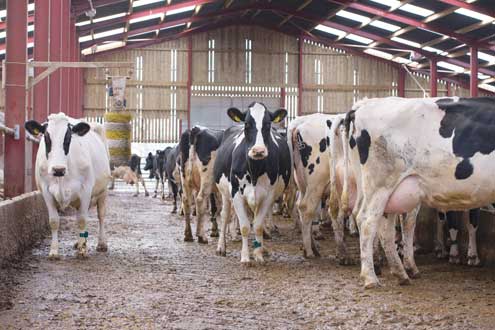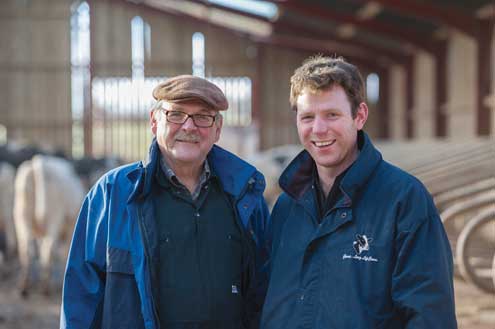Journey to eradicating Johne’s disease

When father and son Terrig and Edward Morgan decided to expand their dairy herd from 130 to 170 cows last year, buying in bovine TB was their biggest concern.
But little did they know they would in fact be opening their herd up to a hidden and insidious disease.
“When we started buying in heifers my biggest worry was bTB. Johne’s was something I hadn’t really thought about,” admits Edward.
But after conducting a 30-cow screening test three months ago, which was fully funded by the advisory service Farming Connect, results revealed the family had introduced their herd to Johne’s disease.
| Carreg Y Llech Farm, Mould, Flintshire |
|---|
|
Originally, Edward was relieved to see only four positive results out of a total of 30 samples taken. But on the face of it the results only scratched the surface of the problem.
“The Morgans have a red-red status, which means they are at the highest risk of introducing Johne’s into the herd due to their recent expansion,” explains vet Dick Sibley of My Healthy Herd. He describes the farm as a “classic example” of Johne’s. “They’ve hardly seen a cow with Johne’s, but they’ve got quite high levels,” he adds.
Mr Sibley says buying in stock presents the biggest and primary risk for many cattle farmers. “It is quite difficult to source cattle that are at zero risk from Johne’s. The quickest way to get rid of Johne’s is to sell it to someone else. It is a real issue for people buying cattle.”
It is likely 30-40% of the herd at Carreg Y Llech are already infected with Johne’s, he says.
This is not an uncommon scenario; in the UK it is estimated more than half of dairy herds are infected with the disease.
“Things are likely to get worse before they get better, because we probably have a generation of youngstock that are infected coming through into the herd,” says Mr Sibley.
| Top tips on buying in cattle |
|---|
|
But without aggressive and proactive management protocols, the situation is unlikely to improve at all.
“By 2017, 90% of the herd would become infected if we carried on with what we are doing,” Mr Sibley warns.
“Doing nothing isn’t an option,” says Edward, who, despite reservations about the task that lies ahead, is adamant to reduce disease prevalence on the farm.
Studies show Johne’s-positive animals yield 4,000kg less milk over their lifetime, are five time more likely to be lame and two times more likely to develop mastitis.
“If it is a big influencing factor on fertility and lameness, it is all the things you don’t want in your herd. Without doing something about it, it is always going to be a problem,” he says.

Risk-based management
The key to controlling Johne’s disease is to prevent the secondary risk of disease – the spread of infection – by effectively managing cows that test positive for disease through risk-based management, says Mr Sibley.
“If there’s no risk of a bought-in cow spreading the disease it leaves the herd with the cow,” he explains.
Fundamental to this approach is monitoring the level of disease prevalence in the herd regularly, by conducting quarterly milk samples. This can be done as part of the NMR milk-testing regime for about £6-10 a cow.
“The first and most important step is testing the herd and monitoring antibody levels. Then, as they rise, we can see a cow is becoming infectious.”
At this stage, Mr Sibley advises tagging any animal that tests positive for the disease with a red tag and treating it as a “leper.”
About 80% of animals with Johne’s are infected with the disease in their first week of life, so preventing transmission to newborn animals is imperative.
“Baby calves have a poor immune system and the gut of neonates is very susceptible to infection.”
| Things you may not know about Johne’s disease |
|---|
|
Risk areas at Carreg Y Llech
Dry cows are housed in cubicles three weeks prior to calving. A combination of rubber matting, sawdust bedding and automatic scrappers provides the ideal environment for low transmission rates.
“The level of contamination is much lower than in a straw yard, because these cows are beautifully clean,” says Mr Sibley.
However, the calving shed, which doubles up as the hospital pen, presents the largest concern.
“We don’t want lepers traipsing through the clean calving pen, so we need an access point where they can get to the sick pen without walking through the calving pen,” says Mr Sibley.
In an ideal situation the hospital and calving sheds would be separate, but a shortage of loose housing prevents this. “This is a problem on a lot of dairy farms,” he adds.
But rather than worry about building a new shed, Mr Sibley advises dividing the hospital and calving pen into two. He says infectious cows should be isolated in the sick pen and newborns must be calved into a “wheel barrow” and removed immediately from their dam to prevent contamination between faeces and milk.
Mr Sibley says accidents during calving can be easily overcome to contain the risk of spread.
“If a calf is born in the middle of the night and you missed it, you have to assume it has become infected and put a red tag in it.”
Mr Sibley says it is unlikely to be infectious and therefore can be put in with the rest of the calves, but says the red tag acts as a precaution in case it becomes contagious as it gets older.
Colostrum management
Post-calving, Mr Sibley says calves should be given clean or freeze-dried colostrum, while pasteurising milk provides an even bigger security.
“Infectious cows in the later stage of disease can excrete the organism in their milk, so feeding raw milk to baby calves is a potential risk,” Mr Sibley explains. He suggests milk from Johne’s-positive animals should be thrown away.
“This year we have fed them all on powder, so they don’t have fresh milk. It is a lot easier,” explains Edward.
However, Mr Sibley says there is an easier way to alleviate the pressure on management capabilities during calving.
At Carreg Y Llech cows are put to a Holstein stock bull for the first eight to 10 weeks. After this, any cows still not in-calf are put to a beef bull. Beef calves and any bull calves are then sold at the local market at three weeks of age, while heifers are kept as replacements.
Instead, Mr Sibley suggests servicing infected cows to beef in the first service.
But the trick to this is understanding her health status prior to bulling.
“If we identify a red cow before bulling her we then put her to a beef bull. Because they [beef calves] are all going to be killed by the time they become infected, Johne’s will never become established in a flying herd.”
Future plans
The Morgans’ expansion plans have nearly reached full fruition. But as they strive to fulfil their target of 180 cows, Mr Sibley warns buying in cattle and stock bulls is going to be a constant risk they will need to manage carefully unless they want to go back to square one.
Key to this, he says, is buying down the risk gradient.
“Always ask the herd of origin their status and never buy from herds worse off than you.”
We will be revisiting the Morgans later in the year to see how they’ve got on with implementing new management protocols and to find out the results of their next Johne’s test.
